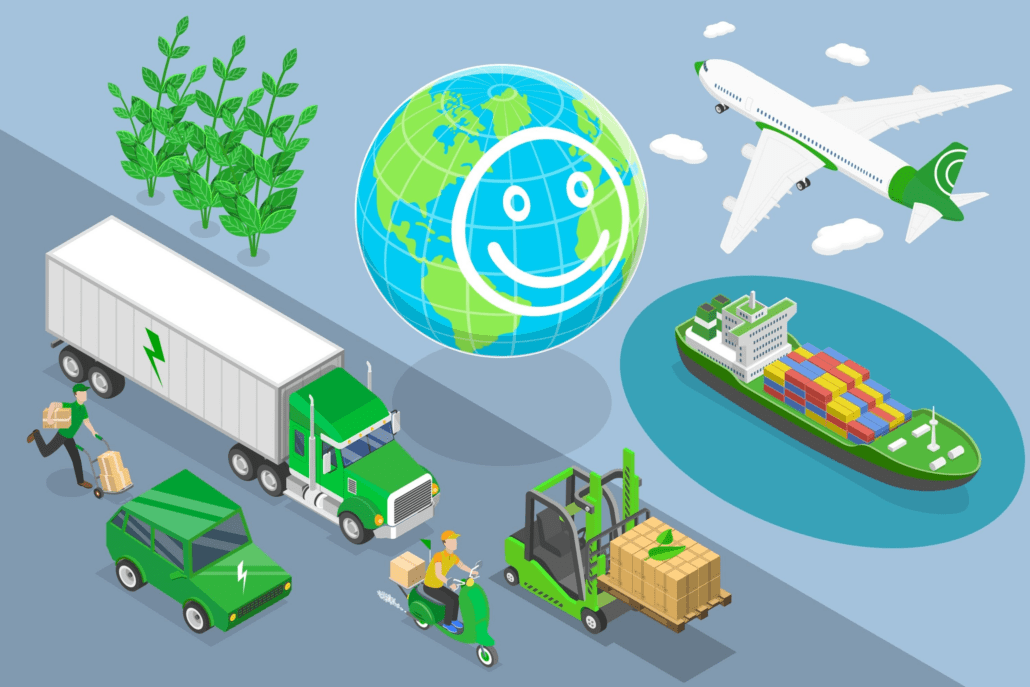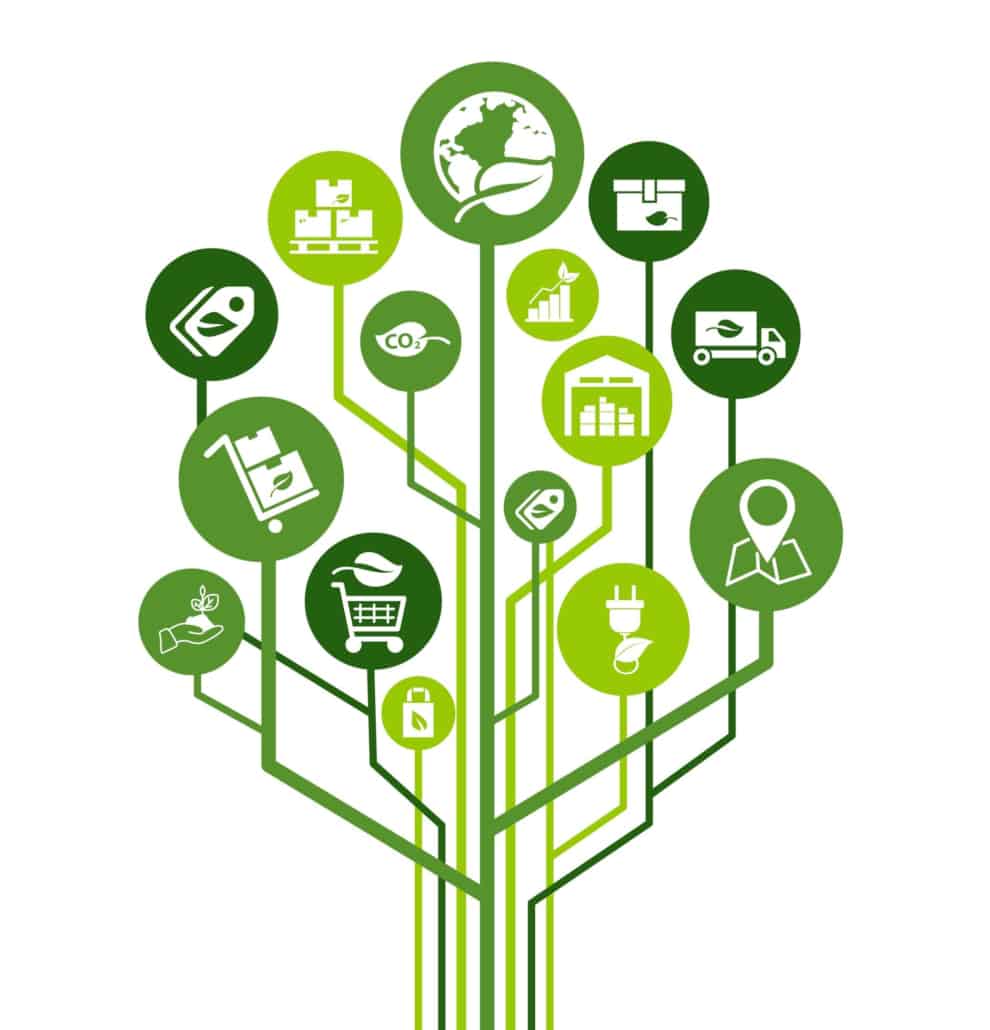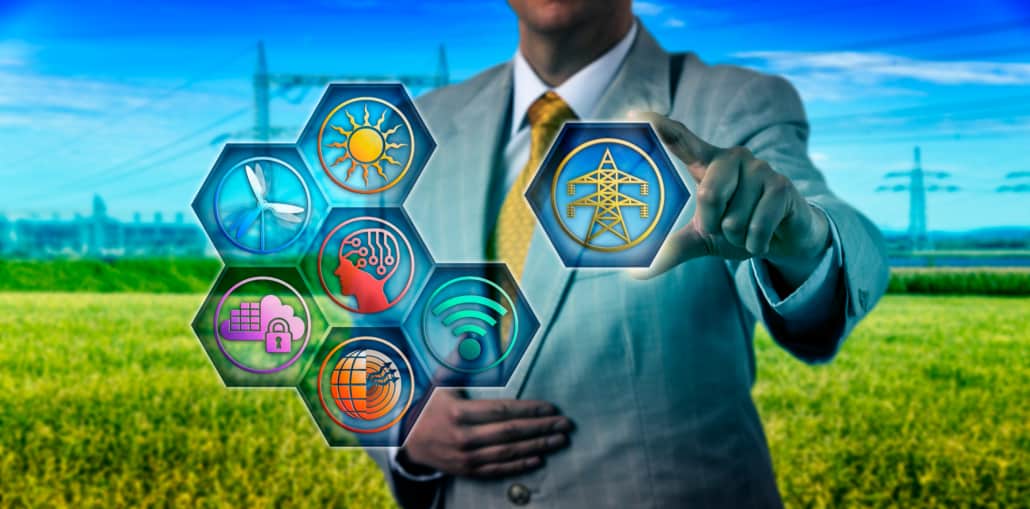Guide to Supply Chain Sustainability 2023
What is supply chain sustainability? Why is it important?
How to develop a sustainable strategy? Check out this guide for evidence-based details!
Table of content:
Table highlighting key sustainable priorities in supply chain management for 2023:
| Sustainable Priority | Key Insights | Value to Businesses |
|---|---|---|
| Renewable Energy Integration | Transitioning to sustainable energy sources | Reduces carbon footprint and operational costs |
| Eco-Friendly Supply Chain Design | Implementing green logistics and packaging | Enhances sustainability and meets regulatory demands |
| Transparency & Compliance | Ensuring ethical sourcing and clear reporting | Builds trust and regulatory adherence |
| Advanced Technologies | Utilizing AI and IoT for sustainable operations | Improves efficiency and resource management |
The Covid-19 pandemic caused significant challenges for companies in the supply chain industry. Most companies were unaware of their operations’ vulnerabilities. Some businesses also realized the problem of outdated systems they used to manage supply chain operations.
Organizations that focused on assessing their supply chain operations during or before the pandemic based on climate conditions, consumer behavior, and market changes perform better than companies that failed to focus on sustainability.
For example, the rising demand for next-day shipping, quality, eco-friendly products, and better customer support are things/changes companies implement to achieve sustainability.
Research shows that delivery speed is one of the critical aspects or factors consumers consider before choosing a retail channel. One study highlights that consumers pay more for ecofriendly and sustainable products.
Researchers recommend companies focus on green logistic practices, streamline product quality, and ensure transparent supply chains to attract and retain more customers.
A company that achieves sustainability efficiently and quickly and delivers it meaningfully stands out from the competition. However, this requires supply chain businesses to access real-time data and third-party logistic networks.
The purpose is to achieve end-to-end visibility in supply chain operations. According to the Economist, the Covid-19 pandemic has transformed the business world, including the supply chain ecosystem, meaning companies must adopt new protocols and implement unique strategies to overcome challenges.
Experts suggest companies increase their reliance on cutting-edge technologies to streamline manufacturing and supply chain operations. Otherwise, achieving sustainability is impossible. Today’s article will explain the importance of supply chain sustainability and best practices to optimize the overall process. Read on!
Renewable energy comes from naturally replenishing sources, such as hydro power, biomass, wind, solar, and geothermal. It provides clean, reliable, and safe power with lower or zero carbon emissions.
On the other hand, fossil fuels, including natural gas, oil, coal, and nuclear power are directly proportional to increased carbon emissions that negatively impact natural ecosystems and lead to global warming.
Companies must treat renewable energy as a strategic asset instead of considering it a tactical expense. This is because renewable energy offers risk management and cost benefits across the supply chain.
Besides, It provides a company with a more predictable, reliable, and consistent energy supply than nuclear energy and fossil fuels. So, renewable energy is an excellent way to reduce risks and streamline manufacturing, logistics, transportation, and distribution of goods.
Onsite renewable energy sources, such as solar or wind power, align with storage devices and fuel cells, providing uninterrupted power to businesses and allowing them to optimize their supply chain functions.
Most companies procure offsite renewable energy to achieve scale. You can streamline the process through power purchase agreements or PPA. The PPA offers electricity and other forms of renewable energy at a fixed price. You can even have 15-20 years of PPA contract.
Instead of adopting the monthly electricity bill payment strategy, long-term energy procurement through PPA contracts is a sustainable practice to manage material input and optimize the cost structure.
Similarly, you can generate higher revenues and ROIs by implementing a renewable energy policy in the supply chain. Remember, consumers, choose products and purchase from companies that are more ecofriendly and socially responsible in their operations.
 According to Green Biz, companies implementing sustainable strategies increase their revenues by 91%. So, it would help if you had renewable energy in your supply chain to prevent risks and cost implications of fossil fuel price changes. At the same time, a solid policy is essential to overcome challenges and:
According to Green Biz, companies implementing sustainable strategies increase their revenues by 91%. So, it would help if you had renewable energy in your supply chain to prevent risks and cost implications of fossil fuel price changes. At the same time, a solid policy is essential to overcome challenges and:
Similarly, renewable energy can improve supply chains by providing price stability, decreasing long-term costs, and reducing future risks. It also improves brand value and reputation, drives new revenues, and enhances employee engagement.
However, renewable energy in the supply chain sector requires companies to perform thorough feasibility assessments based on resources and infrastructure availability.
It also requires you to evaluate investment strategy and determine the financial return. The good news is that renewable energy has become more accessible and affordable in recent years. So, assess your supply chain operations, collect real-time data, and analyze it to generate insights.
You can use these insights to make informed decisions and switch to renewable energy sources, such as biomass, geothermal, solar, wind, and hydropower. You will realize the benefits of these energy sources quickly. Other benefits include:
A study by IBM highlights that about 80% of consumers consider eco-friendliness and sustainability factors when choosing products and services. 60% of people in the U.S. are looking for ways to reduce environmental impact.
Most consumers think changing shopping habits is critical to achieving sustainability. 93% of consumers agree that the Covid-19 pandemic influenced their thoughts and viewpoints about eco-friendliness and sustainability.
So, companies that create sustainability policies and implement ecofriendly practices can streamline supply chain operations and achieve transparency, efficiency, and reliability.

According to a PWC survey, 7% of supply chain companies implementing sustainable practices experience reduced costs and higher revenues. In addition to sustainability practices, over 6,000 senior supply chain executives said digital transformation is essential to decreasing supply chain costs and streamlining operations by eliminating redundancies and leveraging real-time data.
According to Forbes, 88% of consumers remain loyal to businesses that focus on environmental and social responsibility. Consumer awareness and preference for companies with social, ethical, and environmental responsibility increased during the Covid-19 pandemic.
Fortune reports that companies remained under intense pressure during the Covid-19 pandemic because consumers required them to implement sustainable strategies. Likewise, there is a need for more transparency in supply chain practices.
Moreover, a study conducted by the IBM institute for business value states that 69% of people say they accept a job with a socially and environmentally sustainable company. Similarly, over 20% of CEOs say that sustainability can improve the recruitment process and streamline the onboarding of talented candidates.
Sometimes, a dangerous, low-quality or tainted product slips through the cracks and goes into the supply chain. It causes severe consequences for the manufacturer and supplier, destroying the company’s reputation and leading to lower revenues because consumers do not buy from them.
In addition to the reputational damage, companies experience legal penalties. On the other hand, when you enforce and implement supply chain transparency with digital security and streamline sustainability, you can reduce risks by ending the partnership with unscrupulous manufacturers.
Sustainable practices + digital transformation are directly proportional to protecting your business from environmentally irresponsible and unethical partners. You can track and document materials components, the labor involved in the process, and the security of final products. The purpose is to ensure everything goes smoothly from source to destination.

Research highlights 57% of business owners in the supply chain industry are unaware of the “environmental, social, and governance” (ESG) issues and how they can impact their business bottom line.
According to Deloitte, consumers focus on specific brand values when shopping for products. These values are ethically responsible and environmentally sustainable products and packaging.
In addition, consumers focus on buying household products that reduce waste and carbon footprint. That’s why companies in the supply chain industry must align their operations with ESG goals.
The purpose is to reduce waste and implement lean principles to increase revenues and decrease costs. According to the World Economic Forum, companies set more aggressive targets for sustainability in the supply chain, realize the impact of competitiveness, and link those targets to senior executive pay performance.
So, working strategically and focusing on issues like socioeconomic inclusion and emission reduction is an excellent way to reduce costs and increase revenues. The World Economic Forum recommends companies bring in entrepreneurship via incubator programs to streamline supply chain sustainability and implement solutions that meet the ESG goals.
A sustainable supply chain uses socially and environmentally responsible practices at each stage to protect the environment, people, and society across the chain. Simply put, you must uphold social and environmental standards for your operations.
For instance, the environmental standards include problems like degradation, deforestation, pollution, greenhouse gas emissions, and water security. Likewise, the social issues involve working conditions, fair labor practices, forced labor, and employees’ health and safety.
Most companies misunderstand sustainability because they think it means “environmentally sustainable.” Although eco-friendliness is integral to sustainability, businesses must use this term for social and governance-related tasks/projects/operations.
Ethical, social, communal, governance, and organizational sustainability is as crucial as environmental sustainability. For example, a manufacturing company has developed a product that benefits the environment. However, the same product causes adverse effects on workers and local communities. So, in that case, you can’t declare it as a sustainable product. Here are the steps to achieve supply chain sustainability.
Until recently, most companies in the supply chain industry considered sustainability as eco-friendliness. However, the Covid-19 pandemic has changed the entire spectrum of sustainability. Today, the term has become more holistic, focusing on different aspects of supply chain sustainability.
These include “green,” “transparent,” and “circular” supply chains. Understanding these components is essential to implementing a solid strategy and ensuring a risk-free sustainable supply chain. Let us explain each of these sustainability components.
As the name indicates, a green supply chain requires companies to implement environmentally responsible strategies with protocols, principles, and benchmarks that align with the current supply chain conditions.
The primary objective is improving supply chain management and producing eco-friendly products. So this includes green product design, material sourcing, reducing carbon emissions during manufacturing, and ensuring sustainability in logistics and end-of-life product management.
So, businesses must focus on finding and implementing resilient solutions to green their supply chain operations. Not only does this lead to improved brand reputation, but it also ensures transparency and boosts a company’s bottom line.
For instance, you can implement artificial intelligence and machine learning algorithms to develop systems that identify risks, opportunities, trends, and patterns in real time. The goal is to reduce waste, improve efficiency, and generate higher ROIs.
A transparent supply chain is an essential component of sustainability, allowing companies to disclose information about goods, labor, and end-to-end operations or practices in the supply chain. The primary objective of supply chain transparency is to increase trust, eliminate ambiguities, and streamline operations.
Therefore, you must invest your time and resources to establish and maintain environmentally, socially, and ethically responsible standards throughout your supply chain. The issue is that most businesses lack training programs to enforce and implement reliable solutions.
By investing in training programs and focusing on digital technologies, such as AI, machine learning, blockchain, RFID sensors, and the internet of things (IoT), businesses can obtain irrefutable and accurate records of all products and analyze real-time data to generate valuable insights. These insights can help you modify your strategy and optimize your supply chain journey, leading to transparency and sustainability.

A circular supply chain is integral to achieving sustainability. It requires a company to disassemble or reduce products to their raw materials and remanufacture products based on ethical, eco-friendly, and socially responsible principles.
The purpose is to leverage recycling and recoup costs. According to Gartner, a circular supply chain is a successful model, and about 70% of businesses in the supply chain plan to invest in this model.
Modern technologies can support the circular economy. For instance, recycled plastics for manufacturing 3D printers with advanced analytics can streamline logistic journeys and optimize product return into the supply chain loop.
Most companies in the global supply chain use low-tier suppliers. Pressure from consumers and other stakeholders forced businesses during the Covid-19 pandemic to improve transparency and sustainability in supply chains.
However, businesses find it challenging to comply with ethical and green operational standards. The problem is in its worst condition in third-world countries. The good news is that companies can overcome this problem through collaboration and data sharing.
According to the Fashion Transparency Index, supply chain transparency has improved in the industry through sharing real-time data and companies’ collaboration. Working together can help supply chain companies better predict future demands.
In addition, supply chain analytics and programs/software solutions based on predictive modeling and machine learning can help organizations decide on sustainable and ethical sourcing of materials and developing products suitable for the environment, society, and consumers.
Setting benchmarks, goals, targets, and guidelines is essential to developing a sophisticated supply chain sustainability plan. However, this requires you to collaborate with all stakeholders and get everyone on board.
Businesses can seek help from third-party services to set sustainability goals and meet the ESG criteria. Fortunately, digital technologies can streamline the process, allowing companies to track and manage compliance.
According to the Bank of America, companies with a better ESG record than their competitors generate three times higher ROIs. These companies have better brand recognition and reputation among consumers, retailers, and other stakeholders.
Supply chain sustainability is impossible without the leverage of digital technologies. Digital transformation enables companies to meet and exceed supply chain sustainability benchmarks.
At the same time, it innovates and grows business operations, allowing you to achieve sustainability, brand reputation, and higher returns on investments. We recommend focusing on the following technologies to improve your supply chain operations.
Artificial Intelligence curates and analyzes large volumes of data, allowing companies in the supply chain to generate insights from real-time and accurate data. For example, you can track the location and status of packages/products in real time.
It helps you save time and resources and achieve sustainability by ensuring everything goes smoothly throughout the supply chain without redundancy. Machine learning is a critical application of artificial intelligence.
It uses big data to streamline the system’s functions by discovering patterns, analyzing trends, and learning from past experiences. It also automates agile and responsive workflows within supply chain operations, leading to reduced waste and energy usage.
Automation is directly proportional to saving time and money. For example, supply chain companies implementing robotics and automated tools can reduce shipping times by 149%.
Because consumers expect efficient, fast, or next-day delivery, automation can help companies streamline warehousing and logistic operations without hassle. Moreover, inventory management robots and drones can automate and optimize the supply chain workflows, optimize energy utilization, and save money on fossil fuel usage in the supply chain or logistic network.
3D printing is an innovative technology to streamline additive manufacturing. It enables companies to maintain virtual inventories and optimize manufacturing procedures based on demand.
For example, onsite and on-demand manufacturing is an excellent way to eliminate fossil fuel utilization in overseas packing and shipping. The additive manufacturing technology uses recycled plastics from the supply chain loop, leading to eco-friendliness and sustainability.
The internet of things (IoT) can transform the supply chain industry. For example, connected devices can optimize sending and receiving of digital data, removing redundancy, uncertainty, and ambiguity.
IoT is directly proportional to improving supply chain asset intelligence and achieving sustainability. Not only do IoT devices optimize machine performance during manufacturing, but they also automate maintenance, leading to reduced energy usage and the elimination of workflow redundancies.
Moreover, you can fit RFID sensors or devices into products and raw materials to tracking where they go, from the source to destination throughout the supply chain. When businesses comply with mandatory sensor attachment, it ensures transparency and sustainability. The reason is that you can track the products/shipping in real time.
The final step is to implement a green marketing strategy. Consumers don’t know and understand what you don’t tell them. So, if you want to achieve supply chain sustainability, promote your brand and stand out from the competition.
According to Forbes Magazine, green marketing is an excellent way to improve brand image and reputation, increasing consumer loyalty and boosting the business’s overall bottom line. Green marketing requires companies to:
Besides, green marketing requires you to use environmentally-friendly paper and inks for print materials, switch from traditional marketing to online marketing, adopt responsible and ethical waste disposal practices, and use efficient packing and shipping techniques.
Supply chain sustainability is the need of the hour to overcome current and future challenges and embed social, environmental, and fair corporate governance modalities throughout the supply chain.
Supply chain sustainability can help businesses enhance their relationships with stakeholders and customers. Because consumers become increasingly aware of eco-friendliness and social responsibility, they connect their purchasing decisions with specific aspects of the supply chain.
Therefore, you must develop a sophisticated plan by setting goals, finding the right technologies, and getting everyone onboard to maintain agile and sustainable practices throughout the supply chain. So, how do you plan to develop a reliable sustainability strategy for your supply chain? Let us know in the comments section. Or contact us for more information!
Shantala joined GPSI’s team in 2022, following her post-graduate diploma in Environmental Management. She is responsible for the ESG Division and the corporate social responsibility strategy. Before joining GPSI, she held several management positions at Bombardier Aerospace as well as Galderma, a company operating in the pharmaceutical and cosmetics industry. She has more than 15 years of experience in procurement, logistic, and production planning. The environment and sustainable development are undoubtedly her greatest passions.

 The Role of Data and Analytics in Supply Chain Management
The Role of Data and Analytics in Supply Chain Management